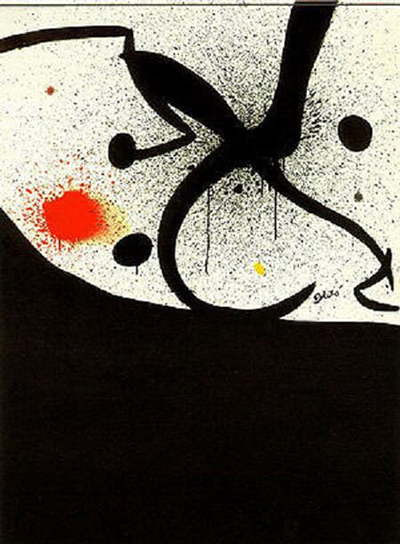Joan Miro produced several different artworks in 1974 that were all titled Bird, Insect, Constellation. This version was the most simple but striking of them all, featuring a long strip of black paint across the bottom and a series of lines above which almost resemble a clock face.
A white circle cuts across the top half of the painting, with a flurry of thick black lines that intersect within the centre. There are also some thick dabs of paint for circles, both in black and also a prominent red to the side. Behind them are much smaller speckled dots which provide the image of a galaxy in the far distance, with planets floating more closely in front. Miro regularly used planets as inspiration for his work, with a red circle normally representing the sun, though not always. Colours was one element that Miro truly mastered, and see here how he reduced the palette down to black and white, before then allowing a red tone in which then really grabs your focus. He preferred small palettes with consistent tones and found this to be highly impactful as he worked hard on his new contemporary style.
He would achieve success eventually by working in this way, but it took time to convince others as to the merits of this new direction. Miro did not always work in this manner, and by 1974, which is when this series of Bird, Insect, Constellation items would be produced, he was very much nearing the end of his career. In previous decades he had worked within other movements such as Surrealism and Cubism, and also spent time developing his abstract work, which eventually was formed from a series of symbols which he used across multiple artworks. He would also be influenced by events in the world, such as war, which would impact his mood and living arrangements. It would also influence the mediums in which he worked, where sometimes certain resources would simply not be available.
Few artists have left more of an impact on the direction of modern art than Miro. He would collaborate with other famous names, particuarly in his early years, and this brought him in contact with all manner of other ideas which could help him to shape his future work. He retained a strong uniqueness to his oeuvre though, and also took on a variety of different disciplines rather than just sticking to oil painting throughout. Today he is widely regarded as one of the most important Spanish artists in history, and as a Catalan he has also added yet more to this region's cultural achievements. Today he remains just as popular as ever and his work achieved extraordinary valuations on the rare occasions that it comes up for sale.




